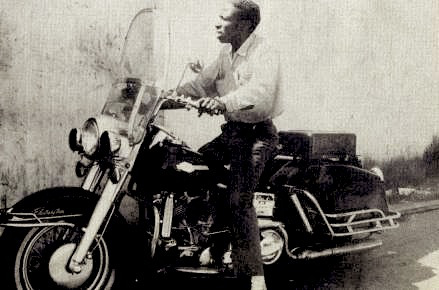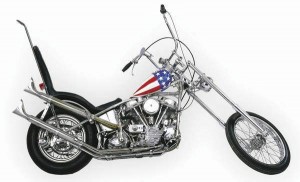
Ben Hardy, born Benjamin F. Hardy, was an African-American motorcycle engineer and chopper builder, who is best known for creating the customized choppers for the characters ‘Captain America’ and ‘Billy’ which featured in the 1969 Peter Fonda road movie Easy Rider, a movie which influenced more people to take an interest in motorcycles and choppers than any other.
Story goes– Peter Fonda, the producer of Easy Rider, hired Cliff Vaughs to coordinate the motorcycles for the film, and Cliff tapped Ben Hardy for the actual construction of the machines. In total, four former police bikes were used in the film. The 1949, 1950 and 1952 Harley Davidson HydraGlide bikes were purchased at an auction for $500. Ben Hardy took the standard H-D frames and used Buchanan’s frame shop to alter the steering head angle to 45 degrees. The steering head was cut off and repositioned, and the resultant extreme rake required a 12″ extension to the telescopic forks. A set of A.E.E. fork clamps are used, with extended handlebar clamps (‘dog bones’); the handlebars have a rise of 13″ – not yet in ‘ape hanger’ territory.
 The Captain America bike, made from a then 20 year old, heavily customized Harley-Davidson panhead is considered one of the most iconic motorcycles ever built, one which captured the zeitgeist of a generation and became an anti-establishment symbol.
The Captain America bike, made from a then 20 year old, heavily customized Harley-Davidson panhead is considered one of the most iconic motorcycles ever built, one which captured the zeitgeist of a generation and became an anti-establishment symbol.
Working with another Black motorcycle builder, coordinator Cliff Vaughs, Hardy built two ‘Billy’ bikes and three ‘Captain Americas’, one of which was destroyed in the making of the movie, the rest of which were stolen. The ‘Billy’ bike was typical of the custom motorcycles Black bikers were riding at the time.
Hardy and Vaughs remained largely unknown and uncredited for 25 years as they were not accepted as being equal due to their color and, as African-Americans, were not welcomed into the mainstream white motorcycle world in the USA.
Known locally as “Benny” and “King of Bikes” Ben Hardy’s Motorcycle Service was located at 1168 E. Florence in Los Angeles. He was a mentor to many of the local motorcyclists in South Central, Los Angeles.
His work was featured in the “Black Chrome” exhibition at the California African American Museum.

